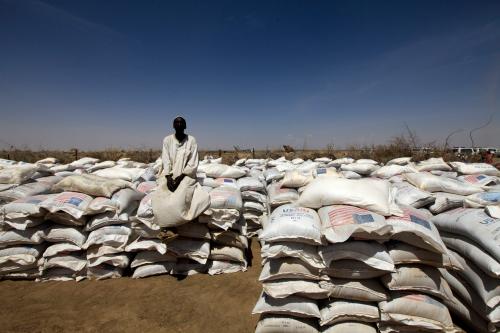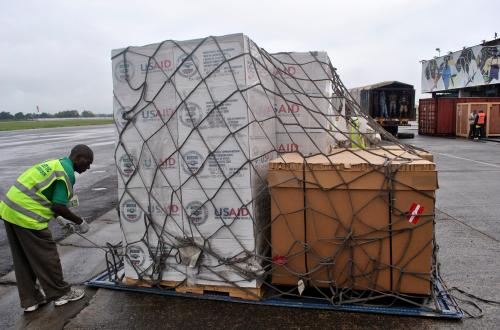Over the past decade aid transparency has moved from being a little-known concept to the norm. The value of making timely and accurate aid data publicly available is now widely accepted as essential to good decision-making. Good data is the foundation of rigorous monitoring and real-time feedback, and is at the heart of transparency and accountability. Without good data, it is hard for stakeholders and citizens to follow and understand the programs of a development agency. After less than a decade of campaigning, however, we can be proud that the discussion has moved from whether to be transparent, to how.
To help with this endeavor, Friends of Publish What You Fund is today releasing the results of an independent assessment, How Can Data Revolutionize Development? The review is focused on the policies and actions of the U.S. government foreign affairs agencies, as well as the role of U.S. civil society in advocating for greater aid transparency. It is structured to highlight lessons learned and draw out recommendations from those lessons. Friends is also releasing a companion document, The Data Revolution and U.S. Global Development, that highlights steps that can be taken by the new administration and Congress to advance the U.S. commitment to aid transparency.
The heightened focus on transparency and data started with the Bush administration’s creation of the Millennium Challenge Corporation (MCC) and the President’s Emergency Plan for AIDS Relief (PEPFAR), and then built up momentum with the Obama administration’s commitment to open and transparent government across all U.S. foreign assistance agencies.
The overall conclusion of the assessment is that considerable progress has been made, but further work is in order. The noteworthy progress by the U.S. government is evidenced in the annual Aid Transparency Index produced by Publish What You Fund. The index rates progress in the major donor agencies, including the six principal U.S. agencies/initiatives that provide assistance: U.S. Agency for International Development (USAID), MCC, the Department of State, PEPFAR, the Department of Defense, and the Department of the Treasury. By 2013, MCC ranked number one globally and is presently ranked number two in the 2016 index. Other U.S. agencies have struggled. By 2016, however, all U.S. agencies ranked “fair” or above—with several approaching “good.” This demonstrates that U.S. agencies are on the right path but still have further to go.
The report examines the principal hurdles to making aid data publicly available. In 2011, the U.S. committed to the International Aid Transparency Initiative (IATI)—the global standard for making aid information publicly available that now has over 480 organizations publishing data. While this commitment was a strong step forward in terms of policy, the report shows that most U.S. agencies have been slow to act.
For several years, agencies did not understand what was needed to meet the IATI commitment. By far, the biggest hurdle is the U.S. data management systems, which were never designed to publish the kind of information that IATI requires. On the whole, investments to meet these needs were slow to materialize, although USAID now has a solution underway that will substantially improve both the process and quality of its published data. The report provides a number of recommendations to improve quality, as well as comprehensiveness and timeliness.
Data quality issues have also hampered data use. There has been a slow uptake in use of IATI information. The report lays out a number of recommendations to drive both demand and capacity, including more internal use of IATI data by the government and nongovernmental organizations that publish to IATI.
Although progress has not been as fast as many of us would have liked, the past decade has brought a sea change in aid transparency. To move forward, the U.S. needs to not only double down on improvements to its IATI data but also deepen commitments in two specific areas: humanitarian assistance and gender-related data.
There is urgency for better data to meet humanitarian emergencies. As an example, timely data was lacking during the Ebola crisis. Organizations needed to know where the demand for care was not being met. They needed to know where clinics were overloaded and where they were underused. Without this data, it was difficult to properly direct resources and save as many lives as possible. The humanitarian community has recognized this deficiency and at the 2016 World Humanitarian Summit in Istanbul orchestrated a “grand bargain” that, among other reforms, commits donors to data transparency in the humanitarian arena. The U.S.—the largest bilateral donor of humanitarian assistance and signer to the grand bargain—must now implement this pledge.
Girls and women are essential to development advancement. Despite consensus on this, too often they remain an afterthought. The Sustainable Development Goals (SDGs) put women and girls at their center—but the gender data-deficit remains severe. The U.S. needs to address this by advancing data gender disaggregation, so that programming and impact are data-informed and data-driven.
To achieve these data milestones requires political leadership, a modicum of dedicated financial and human resources, and attention to data use, needs, and demands. In short, the new administration needs to put data at the core of U.S. development programs.
As the world’s largest bilateral provider of assistance, the U.S. has both the burden and privilege of leadership. In transparency, the U.S. is the essential partner—without the U.S. effectively publishing its data, the global data effort will not achieve critical mass. The U.S. has been a leader and partner in open government and now has the opportunity to exert its leadership in aid transparency.







Commentary
U.S. aid transparency: Looking back but pressing forward
October 21, 2016